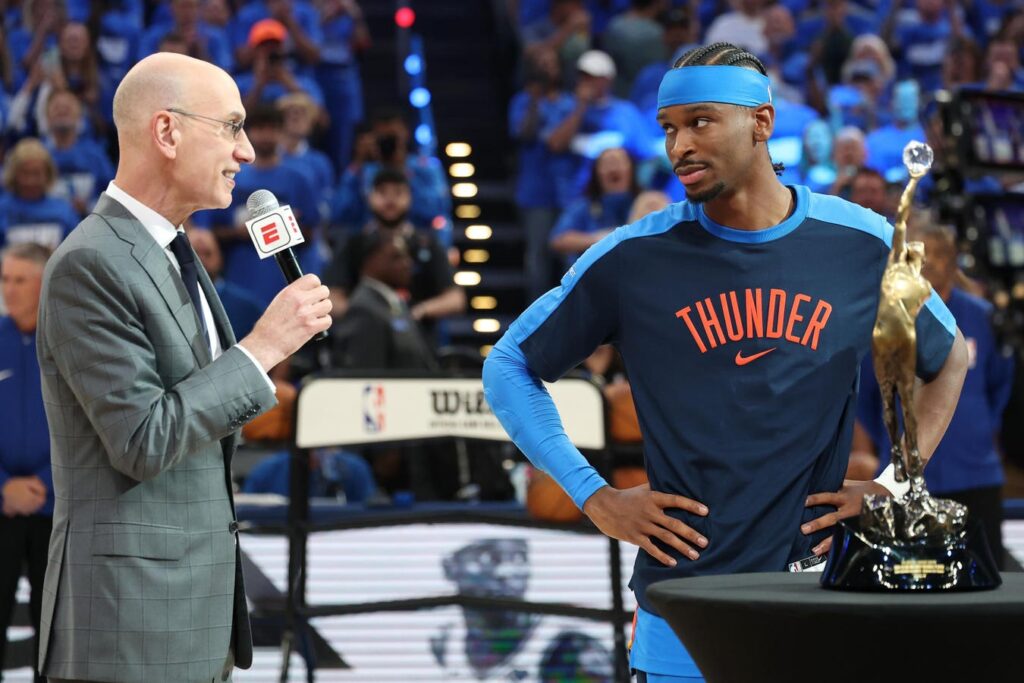OKLAHOMA CITY, OKLAHOMA – MAY 22: Commissioner of the NBA Adam Silver presents Shai … More
Getty ImagesThe NFL has long prided itself on perceived parity as a staple of its appeal.
A national (and increasingly, international) TV product, larger rosters than other sports, and salary cap machinations have been great equalizers for the NFL’s 32 franchises. Big markets can’t win out versus solid team-building in the NFL. And in fact, some of the biggest fan bases exist around some of the league’s “smaller-market” teams – including the Green Bay Packers and Pittsburgh Steelers.
As a result, the Super Bowl has been the most-watched event on TV for decades no matter who’s playing, while regular season NFL games regularly outdraw championship rounds for the NBA, NHL and MLB.
Understanding all of this, as most observers of televised sports do, NBA Commissioner Adam Silver’s comments on Fox Sports 1’s Breakfast Ball this week get all the more confusing.
“If we were going into a Super Bowl and it was Packers against Steelers, you guys would be celebrating that. Those would be storied franchises. People wouldn’t be talking about the fact that Pittsburgh is a small market. I’m happy whatever team ends up in the Finals, but it’s been intentional from our standpoint to create a system, a collective bargaining agreement, that allows more teams to compete.”
Where It Falls Apart
The idea of the NBA promoting more parity is not a bad one, considering how little of it has existed in the league until recently.
Nearly 45% of the league’s championships have been won by two franchises, the Boston Celtics and Los Angeles Lakers. This year’s seventh different champion in seven years – a list that includes both the Celtics and Lakers – is a glaring exception in league history. In part, it’s why more NBA teams lack the national and international followings of those two clubs.
The other, of course, is simply the regional nature of the NBA’s day-to-day business, compared to the NFL.
Beyond the playoffs, NBA Draft, and flurry of early-summer free agency moves, the large majority of the NBA calendar plays out on regional sports networks. Teams with the most national TV dates (a list that typically includes the Celtics and Lakers, among others) still tops out at 25-30 games. So for even the most popular squads, that leaves 50 or so games limited to regional fans or League Pass subscribers.
Compare this to the NFL, where every game has national exposure, and it’s easy to see how any Super Bowl matchup is a hit. The problem with Silver’s specific comparison, of course, is that he also picked a Packers-Steelers matchup that ranked among the 10 most-watched U.S. TV programs of all time when the teams actually met in the Super Bowl back in 2011.
This year’s NBA Finals opponents, the Indiana Pacers and Oklahoma City Thunder, are not the Packers and Steelers in terms of history or fan interest. But they also shouldn’t be tasked to be. Their success this year simply highlights where the NBA still has room to grow as a national TV product.
INDIANAPOLIS, INDIANA – MAY 10: Tyrese Haliburton #0 of the Indiana Pacers reacts after his made … More
Getty ImagesNBA’s Short-And Long-Term TV Outlook
The Pacers’ thrilling Game One win over the Thunder may help generate further interest in the rest of this year’s Finals. But the league still has an uphill battle ahead to overcome the size of its competitors’ fan base sizes and TV markets.
Accepting that, and the likely low ratings that will result, focus now turns to how the new NBA media rights deal – worth a reported $76 billion over 11 years. That’s a 160% increase on a per-season basis compared to the current contracts. Yet, it’s still about $2.5 billion per year less than what the NFL’s existing media deal takes home.
When the NFL’s media rights come up for bid once again, that distance is very likely to increase even more. So it’s best for the league to avoid comparisons, and rather stand on (and improve) its own merits.
Where the NBA can improve under a new TV deal is by leveraging partners at Amazon, NBCUniversal and Disney to elevate its teams beyond the current regional constraints.
More national TV games and primetime windows at least five nights per week will help there. But Amazon Prime Video, in particular, could play a unique role turning regional broadcasts into more national inventory. The tech giant’s existing regional network partnerships could potentially present themselves as additional “national” inventory on the Prime Video platform, expanding attention for those games to more casual fans.
The new TV contract also presents an opportunity for the league to adjust how it covers its teams and its biggest stars on equal footing.
Though the NFL has its favored players and teams, win-loss record is still the primary metric of success that dictates coverage. For the NBA, a “small-market” Finals could be used as a springboard to spotlight smart team building, younger stars and help teams like the Pacers and Thunder further break out of perceived regional boxes. And that, in turn, makes it easier to award more primetime TV placements spread across all teams, and not just the larger markets.
It won’t happen overnight. But if the NBA and its partners truly invest in becoming a national, and parity-driven league, then Silver’s comments may actually ring prescient one day.
Read the full article here


